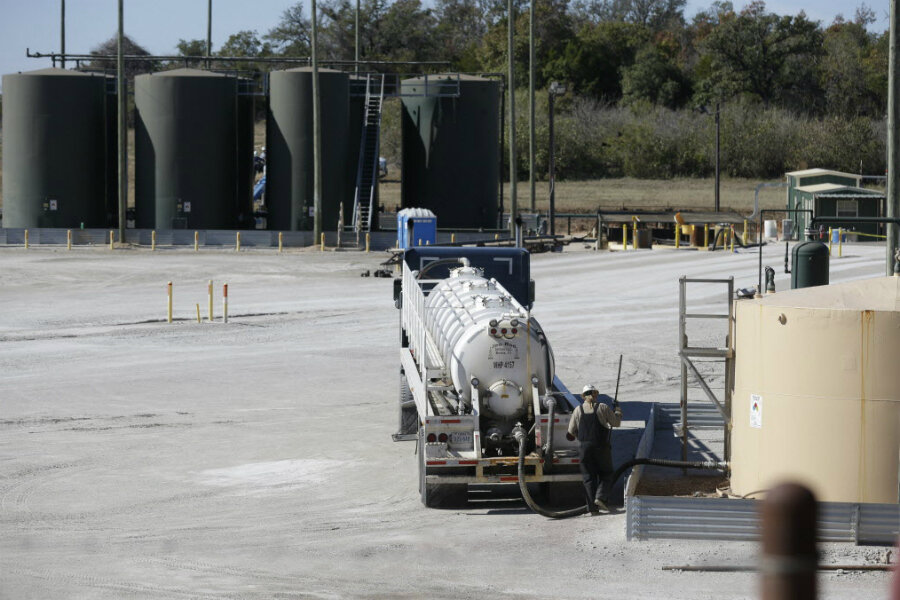'Man-made' earthquakes: Is fracking adding to seismic activity in US?
Loading...
Earthquakes are becoming more frequent and more intense in the US, including "man-made" earthquakes in areas not near a fault line, according to two studies released this week.
The new earthquake hazard map from researchers at the US Geological Survey points out 17 typically dormant areas where wastewater injections from hydraulic fracturing operations might be the root cause of high seismic activity.
Oklahoma is leading the way, registering more quakes of magnitude 3 or higher than California last year, according to the report released earlier this week. The state's seismicity rate was 70 times greater than the background seismicity rate observed prior to 2008, according to state officials.
Moreover, Oklahoma's sharp rise in quakes is "very unlikely to represent a naturally occurring process," since the quakes are occurring over the same area that saw a big jump in wastewater injections over the last several years, according to a report released on Tuesday by the Oklahoma Geological Survey.
"These earthquakes are occurring at a higher rate than ever before, and pose a much greater risk and threat to people living nearby," said Mark Petersen, chief of the USGS's National Seismic Hazard Modeling Project and lead author of the report, in a statement with Thursday's release.
One such event in 2011 near Prague, Okla., where workers had been injecting wastewater underground for 18 years, triggered a magnitude 5.6 quake strong enough to buckle a highway and destroy 14 homes, slightly injuring two people.
The USGS study investigated 50 years of earthquake activity in 17 "induced seismicity zones" across eight states. While the study found areas without much history of seismic activity experiencing more earthquakes, it also identified several areas that don't seem to be unduly affected by the presence of injection wells.
Other regions found to be vulnerable to man-made quakes include the Raton Basin in southern Colorado and northern New Mexico, which saw a big jump in earthquakes since 2001, two years after the pace of oil extraction increased in the region. Areas in Texas, Kansas, New Mexico, and Ohio also have all experienced more frequent quakes in the last year, according to the report.
The study, however, found no evidence of seismic activity in popular drilling sites like the Los Angeles Basin and the Bakken Shale in North Dakota.
By studying regions where wastewater injections have not caused an increase in seismic activity, researchers say they hope to find ways to continue drilling safely without disturbing seismic faults and not putting lives or property at risk.
Differences in local geology and drilling methods could be some of the reasons why some areas experience less seismic activity despite lots of drilling in the region. Drillers in Oklahoma have to break through dense shale rock to reach oil and gas deposits. Improved seismic sensors in the ground can also help scientists detect smaller earthquakes, according to researchers.
One factor widely agreed upon among scientists is that small earthquakes are the canaries in the coal mine for larger earthquakes down the road.
"If you're disposing the water, and you get no earthquakes, you're fine. But if you start getting a few small earthquakes, you should probably stop," said Egill Hauksson, a seismologist at the California Institute of Technology who was not involved in the USGS report, "because if you keep going, you might get another big earthquake."
Another study released this week by a multi-agency team of researchers found that half the US population is more vulnerable to earthquakes than ever before.
According to the study, 143 million Americans live in earthquake-prone areas in the lower 48 states. This is up from 75 million Americans in 35 states, according to a 1991 report from the Federal Emergency Management Agency.
Improved data collection and computing power has allowed scientists to get more accurate readings on when and where earthquakes may occur, and how strong they'll be. A recent study from the USGS predicted that the next megaquake in California may come earlier than expected.
The research team – including scientists from the USGS, FEMA, and the California Geological Society – also calculated the potential financial impacts of earthquakes with the help of 2010 Census data and the 2012 replacement-cost values for buildings. The average cost of earthquake damage in the lower 48 states was $4.5 billion.
More than 6,000 fire stations, 800 hospitals, and almost 20,000 public and private schools are built on shaky ground, according to the study.
"The bottom line is that there are a significant number of structures located amongst higher-hazard levels," said lead researcher Kishor Jaiswal, a USGS contractor, according to Live Science.








